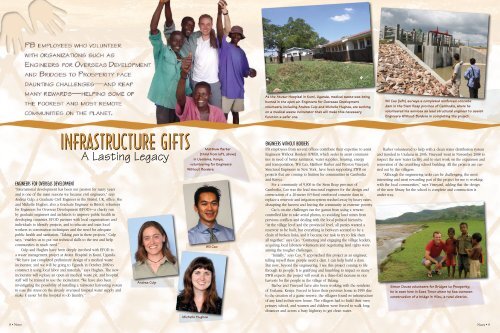Sep 2009 - Parsons Brinckerhoff
Sep 2009 - Parsons Brinckerhoff
Sep 2009 - Parsons Brinckerhoff
Create successful ePaper yourself
Turn your PDF publications into a flip-book with our unique Google optimized e-Paper software.
At the Atutur Hospital in Kumi, Uganda, medical waste was being<br />
burned in the open air. Engineers for Overseas Development<br />
volunteers, including Andrea Culp and Michelle Hughes, are working<br />
on a medical waste incinerator that will make this necessary<br />
function a safer one.<br />
Wil Cao (left) surveys a completed reinforced concrete<br />
dam in the Siem Reap province of Cambodia, where he<br />
volunteered his services as lead structural engineer to assist<br />
Engineers Without Borders in completing the project.<br />
Infrastructure Gifts<br />
Engineers for Overseas Development<br />
“International development has been our passion for many years<br />
and is one of the main reasons we became civil engineers,” says<br />
Andrea Culp, a Graduate Civil Engineer in the Bristol, UK, office. She<br />
and Michelle Hughes, also a Graduate Engineer in Bristol, volunteer<br />
for Engineers for Overseas Development (EFOD)—a charity run<br />
by graduate engineers and architects to improve public health in<br />
developing countries. EFOD partners with local organizations and<br />
individuals to identify projects, and to educate and train local<br />
workers in construction techniques and the need for adequate<br />
public health and sanitation. “Taking part in these projects,” Culp<br />
says, “enables us to put our technical skills to the test and help<br />
communities in much need.”<br />
Culp and Hughes have been deeply involved with EFOD in<br />
a waste management project at Atutur Hospital in Kumi, Uganda.<br />
“We have just completed preliminary design of a medical waste<br />
incinerator, and we will be going to Uganda in October <strong>2009</strong> to<br />
construct it using local labor and materials,” says Hughes. The new<br />
incinerator will replace an open-air medical waste pit, and hospital<br />
staff will be trained to use the incinerator. “We have also been<br />
investigating the possibility of installing a rainwater harvesting system<br />
to ease the stress on the already overused hospital water supply and<br />
make it easier for the hospital to do laundry.”<br />
8 • Notes<br />
A Lasting Legacy<br />
Andrea Culp<br />
Matthew Barber<br />
(third from left, above)<br />
in Usalama, Kenya,<br />
volunteering for Engineers<br />
Without Borders.<br />
Michelle Hughes<br />
Wil Cao<br />
Engineers Without Borders<br />
PB employees from several offices contribute their expertise to assist<br />
Engineers Without Borders (EWB), which seeks to assist communities<br />
in need of better sanitation, water supplies, housing, energy<br />
and transportation. Wil Cao, Matthew Barber and Preston Vineyard,<br />
Structural Engineers in New York, have been supporting EWB on<br />
projects that are coming to fruition for communities in Cambodia<br />
and Kenya.<br />
For a community of 9,000 in the Siem Reap province of<br />
Cambodia, Cao was the lead structural engineer for the design and<br />
construction of a 20-meter (65-foot) reinforced concrete dam to<br />
replace a reservoir and irrigation system washed away by heavy rains,<br />
disrupting the harvest and leaving the community in extreme poverty.<br />
Cao’s on-site challenges ran the gamut from using a remotecontrolled<br />
kite to take aerial photos, to avoiding land mines from<br />
previous conflicts and dealing with the local political hierarchy.<br />
“At the village level and the provincial level, all parties wanted a<br />
reservoir to be built, but everything in between seemed to be a<br />
chain of broken links, and it became our task to try to link them<br />
all together,” says Cao. “Contacting and engaging the village leaders,<br />
acquiring local laborers/volunteers and negotiating land rights were<br />
among the tougher challenges.<br />
“Initially,” says Cao, “I approached this project as an engineer,<br />
telling myself these people need a dam. I can help build a dam.<br />
But now, beyond the engineering, I see this project coming to life<br />
through its people. It is gratifying and humbling to impact so many.”<br />
EWB expects the project will result in a three-fold increase in rice<br />
harvests for the people in the village of Balang.<br />
Barber and Vineyard have also been working with the residents<br />
of Usalama, Kenya. Forced to leave their previous home in 1990 due<br />
to the creation of a game reserve, the villagers found no infrastructure<br />
of any kind in their new home. The villagers had to build their own<br />
primary school, and women and children were forced to walk long<br />
distances and across a busy highway to get clean water.<br />
Barber volunteered to help with a clean water distribution system<br />
and traveled to Usalama in 2006. Vineyard went in November 2008 to<br />
inspect the new water facility and to start work on the expansion and<br />
renovation of the crumbling school building. All the projects are carried<br />
out by the villagers.<br />
“Although the engineering tasks can be challenging, the most<br />
interesting and most rewarding part of the project for me is working<br />
with the local communities,” says Vineyard, adding that the design<br />
of the new library for the school is complete and construction is<br />
under way.<br />
Simon Douse volunteers for Bridges to Prosperity;<br />
he is seen here in East Timor where he has overseen<br />
construction of a bridge in Alieu, a rural district.<br />
Notes • 9
















